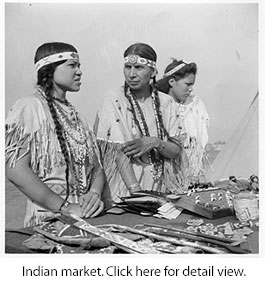|
 here are still many people who confuse the fact that Skookum Indian dolls were commercially manufactured, and not Native-American made. This confusion is easily understood, and is mainly derived from how the dolls were bought and sold. Skookums were commonly acquired in one’s travels to popular tourist or vacation spots. They were bought as mementos of their trip or sent to family and friends as souvenirs. Often the curio or trade shops where the dolls were purchased carried similarly themed material such as other “western” novelties or native-made arts and crafts. Skookum dolls were shelved next to authentic Indian rugs, pots, and blankets, making it easy for the buyer to assume that the dolls were also native-made. To further confuse the consumers, shop owners often employed Native Americans from nearby reservations as sales people. For this reason we often hear people claim that they bought their Skookum doll from “an Indian woman out West,” so it must have been Indian made! here are still many people who confuse the fact that Skookum Indian dolls were commercially manufactured, and not Native-American made. This confusion is easily understood, and is mainly derived from how the dolls were bought and sold. Skookums were commonly acquired in one’s travels to popular tourist or vacation spots. They were bought as mementos of their trip or sent to family and friends as souvenirs. Often the curio or trade shops where the dolls were purchased carried similarly themed material such as other “western” novelties or native-made arts and crafts. Skookum dolls were shelved next to authentic Indian rugs, pots, and blankets, making it easy for the buyer to assume that the dolls were also native-made. To further confuse the consumers, shop owners often employed Native Americans from nearby reservations as sales people. For this reason we often hear people claim that they bought their Skookum doll from “an Indian woman out West,” so it must have been Indian made!
 There are some simple facts that remind us that Skookums were commercially made dolls. First is the fact that composition and plastic are not traditional native mediums. Native arts and crafts have a long tradition of being handmade with natural materials. It is also good to remember the well-documented history of the dolls. In brief, Skookum Indian dolls were created in 1913 by Mary McAboy, a non-indian from Missoula, Montana. Mary soon merged her business with the large manufacturing and distributing company of H.H. Tammen, who went on to mass-produce Skookum dolls for almost 50 years. This is not to imply that Skookum dolls have no artistic value! While the masks were created with molds, the rest of the doll was hand assembled and decorated mostly by American housewives as part of a cottage industry. This accounts for the great variety and personal touch that assures you will never find two Skookums that are exactly alike. There are some simple facts that remind us that Skookums were commercially made dolls. First is the fact that composition and plastic are not traditional native mediums. Native arts and crafts have a long tradition of being handmade with natural materials. It is also good to remember the well-documented history of the dolls. In brief, Skookum Indian dolls were created in 1913 by Mary McAboy, a non-indian from Missoula, Montana. Mary soon merged her business with the large manufacturing and distributing company of H.H. Tammen, who went on to mass-produce Skookum dolls for almost 50 years. This is not to imply that Skookum dolls have no artistic value! While the masks were created with molds, the rest of the doll was hand assembled and decorated mostly by American housewives as part of a cottage industry. This accounts for the great variety and personal touch that assures you will never find two Skookums that are exactly alike.
With all this being said, there may be one exception to this rule. An advertisement in a 1930s novelty catalog states that larger and indian-made Skookums are available through special order. No illustrations or photographs of these particular dolls accompanied this ad. We suspect these are the dolls that were made twenty-inches and up as they are less common and highly decorated—often with beadwork and elaborate headdresses. Now don’t get too excited that a real Indian may have made your Skookum’s headdress! H.H Tammen wasn’t exactly hindered by honesty! This quote from Gene Folwer’s Timber Line: A Story of Bonfils and Tammen illustrates this fact:
“Tammen’s curio business was a success from the beginning. He sold arrows ‘direct from the reservation.’ These weapons were made by schoolboys, vacationing in the basement of Tammen’s store. His moccasins never came from the wigwams of aboriginal manufacturers, but were sewn and beaded by gentle old ladies of the city, who wished to earn pin money.”
Henry Heye Tammen was quite the businessman and character, but that is a whole other story for the next newsletter!
|